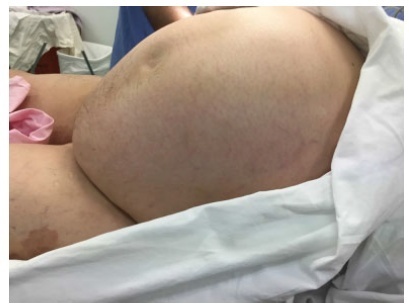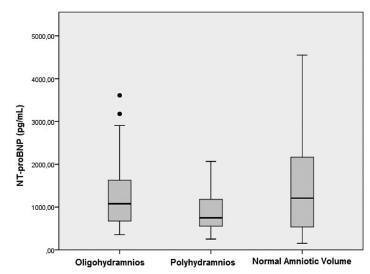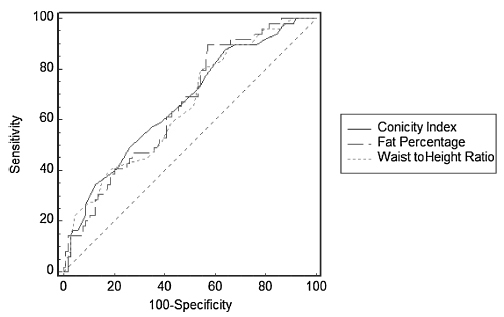-
Original Article04-05-1998
Fine needle aspiration biopsy: performance in the differential diagnosis of palpable breast masses
Revista Brasileira de Ginecologia e Obstetrícia. 1998;20(8):463-467
Abstract
Original ArticleFine needle aspiration biopsy: performance in the differential diagnosis of palpable breast masses
Revista Brasileira de Ginecologia e Obstetrícia. 1998;20(8):463-467
DOI 10.1590/S0100-72031998000800006
Views74See morePurpose: to evaluate, in a prospective way, the performance of the fine needle aspiration biopsy in the differential diagnosis of palpable breast masses. Method: the sensitivity, specificity, positive and negative predictive values for this test were evaluated in 102 women with age above 30 years and a palpable breast mass, who were attended at the University of Campinas. All punctures were performed by the same examiner. Results: the procedure had a sensitivity of 97%, specificity of 87%, positive predictive value of 94% and negative predictive value of 93%. The insufficient or unsatisfactory sample rate was 16% for the first aspiration, decreasing to 2% with a new procedure. Conclusions: this test showed to be highly sensitive and specific for the differential diagnosis of palpable breast masses, reassuring its great importance for the clinical approach of palpable masses.
-
Original Article04-05-1998
A randomized trial of misoprostol and placebo for cervical ripening and induction of labor
Revista Brasileira de Ginecologia e Obstetrícia. 1998;20(8):457-462
Abstract
Original ArticleA randomized trial of misoprostol and placebo for cervical ripening and induction of labor
Revista Brasileira de Ginecologia e Obstetrícia. 1998;20(8):457-462
DOI 10.1590/S0100-72031998000800005
Views124See moreObjective: to determine the efficacy and safety of misoprostol for cervical ripening and induction of labor in pregnant women at term when compared with placebo. Patients and Methods: fifty-one high-risk pregnant women at term, with unripe cervix, were allocated in a double-blind trial for treatment with intravaginal misoprostol (40 mg, 4/4 h) or intravaginal placebo. Results: thirty-two patients received misoprostol and 19 received placebo. The groups were homogeneous concerning maternal age, gestacional age, parity, and indication for induction (p > 0.05). In the misoprostol group the efficacy was 87.5% and in the placebo group 21.1% (p = 0.0000087). Regarding delivery, in the misoprostol group 75% had vaginal delivery and 25% abdominal delivery, and in the placebo group only 32% had vaginal delivery and 68% abdominal delivery (p = 0.0059).The Apgar score was similar. Conclusion: in this study misoprostol was effective and safe for cervical ripening and induction of labor.
-
Original Article04-05-1998
Folate, vitamin B12, serum ferritin and defects of the neural tube
Revista Brasileira de Ginecologia e Obstetrícia. 1998;20(8):449-453
Abstract
Original ArticleFolate, vitamin B12, serum ferritin and defects of the neural tube
Revista Brasileira de Ginecologia e Obstetrícia. 1998;20(8):449-453
DOI 10.1590/S0100-72031998000800004
Views174See morePurpose: to determine folate, vitamin B12 and ferritin levels in patients whose fetuses presented neural-tube defects (NTD). Blood folate and vitamin B12 act as cofactors of enzymes involved in DNA biosynthesis. Interruption of this process may block neural-tube closing. Vitamin supplementation with folate may reduce occurrence rates and recurrence of NTD, although there is concern about the fact that this prevention may mask vitamin B12 deficiency. Methods: vitamin B12 and ferritin determinations by enzyme immunoassay with microparticles and folic acid determination using the ion capture method (IMx ABBOTT). Results: the percentage of pregnant women with vitamin B12 deficirncy (serum levels < 150 pg/ml) was 11.8%. There was no case of folate deficiency (serum levels < 3.0 ng/ml) and prevalence of pregnant women with iron store deficiency was 47.1% (serum levels < ng/mg). Conclusions: occording to the results obtained in this study (prevalence of 11.8% of vitamin B12 and 0% of folate deficient pregnant women) we suggest that supplementation should be administered after serum vitamin B12 determination.
-
Original Article04-05-1998
Amniotic liquid index: study of inter- and intraobserver variability
Revista Brasileira de Ginecologia e Obstetrícia. 1998;20(8):443-448
Abstract
Original ArticleAmniotic liquid index: study of inter- and intraobserver variability
Revista Brasileira de Ginecologia e Obstetrícia. 1998;20(8):443-448
DOI 10.1590/S0100-72031998000800003
Views176See morePurpose: to demonstrate the interobserver variation existing in the ultrasonographic measurement of amniotic fluid index (AFI) and in the measurement of pocket area, and to compare these two methods. In addition, an attempt was made to establish the intraobserver variation in the measurement of this index. Methods: values of AFI, described by Phelan et al.18, were studied in a group of 80 pregnant women considered to be clinically normal, seen at the Ultrasonography and Medical Updating School of Ribeirão Preto and in the Department of Gynecology and Obstetrics of the Faculty of Medicine of Ribeirão Preto, University of São Paulo (FMRP-USP). All pregnant women had a gestational age of more than 24 weeks. Fifty of these patients were submitted to AFI evaluation by 5 different ultrasonographists using the same equipment and during the same period of time, in order to determine the interobserver variation of this index. In addition, planimetric measurement of the area was performed by 2 of these 5 ultrasonographists, selected at random, in an attempt to determine interobserver variation in area measurement. Another group of 30 pregnant women was evaluated by the same ultrasonographist in an attempt to evaluate intraobserver variation in terms of AFI measurement. Results: There was a significant interobserver variation in AFI measurement and a significant variation in area measurement. However, the intraobserver variation in AFI measurement was nonsignificant. There was a correlation between AFI and area measurements. Conclusions: we emphasize the obstetrical applicability of this index and the easier execution of this method compared to area measurement, despite the importance of both procedures.
-
Original Article04-05-1998
Perinatal complications in pregnant women with and without bacterial vaginosis
Revista Brasileira de Ginecologia e Obstetrícia. 1998;20(8):437-441
Abstract
Original ArticlePerinatal complications in pregnant women with and without bacterial vaginosis
Revista Brasileira de Ginecologia e Obstetrícia. 1998;20(8):437-441
DOI 10.1590/S0100-72031998000800002
Views172Purpose:to compare the incidence of preterm labor and birth, premature rupture of membranes (PROM) and low birth-weight newborns (< 2,500 g) between two groups of pregnant women (with or without BV). To verify the adequacy of including a regular prenatal BV investigation. Methods:a total of 217 women between 28 and 32 weeks of pregnancy (35 with BV and 182 without BV) were studied. The diagnosis of BV was established according to Amsel's criteria. The data were analyzed by the chi² test, Fisher's test, Mann-Whitney test and the relative risk. Results:the incidence of preterm labor, preterm birth, PROM and low birth-weight was statistically higher in the group of women with BV than in the control group (29.4% vs. 3.8%; 28.6% vs. 3.3%; 22.9% vs. 10.4%; 20.0% vs. 3.3%; respectively). The means of gestational age and birth-weight were significantly lower in the newborns from mothers with BV (265.8 days vs. 279.9 days; 2,958 g vs. 3,294 g, respectively). Conclusion:all perinatal complications studied were significantly associated with the presence of untreated BV during pregnancy. Therefore, the diagnosis and adequate treatment should be included in the routine prenatal assistance at Brazilian Obstetrics Services. Such measure may be effective in the reduction of these perinatal complications.
Key-words Bacterial vaginosisPregnancy complicationsPremature rupture of membranesPrematurityVulvovaginitisSee more -
04-05-1998
Porquê o título de especialista em ginecologia e obstetrícia da FEBRASGO?
Revista Brasileira de Ginecologia e Obstetrícia. 1998;20(8):435-435
-
04-04-1998
Estudo Prospectivo, Comparativo da Isradipina e Atenolol no Tratamento de Gestantes Hipertensas
Revista Brasileira de Ginecologia e Obstetrícia. 1998;20(10):578-578
Abstract
Estudo Prospectivo, Comparativo da Isradipina e Atenolol no Tratamento de Gestantes Hipertensas
Revista Brasileira de Ginecologia e Obstetrícia. 1998;20(10):578-578
DOI 10.1590/S0100-72031998001000008
Views74Estudo Prospectivo, Comparativo da Isradipina e Atenolol no Tratamento de Gestantes Hipertensas[…]See more -
04-04-1998
A Placenta da Gestante Diabética
Revista Brasileira de Ginecologia e Obstetrícia. 1998;20(10):577-577
Search
Search in:
Tag Cloud
Pregnancy (252)Breast neoplasms (104)Pregnancy complications (104)Risk factors (103)Menopause (88)Ultrasonography (83)Cesarean section (78)Prenatal care (71)Endometriosis (70)Obesity (61)Infertility (57)Quality of life (55)prenatal diagnosis (51)Women's health (48)Maternal mortality (46)Postpartum period (46)Pregnant women (45)Breast (44)Prevalence (43)Uterine cervical neoplasms (43)





